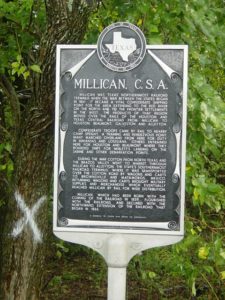 A History of Millican and the Millican United Methodist Church
A History of Millican and the Millican United Methodist Church
Millican: The Settlement
In 1821 Robert Hemphill Millican, a settler from Missouri, was the first frontiersman to bring his wife, sons, and daughters and permanently settle a location about two miles south of the current town site of Millican in south Brazos County. Millican, a member of the Old 300 and Stephen F. Austin’s first colony, was also the first settler in what is now Brazos County. He received 2.5 leagues of land in 1824. Frequent floods, frontier isolation, and threat of malaria did not deter Millican and other early settlers of the area. By 1845 the settlement became known as the Millican Community.
Millican: The Township
By 1860 the Houston and Texas Central Railroad brought about quite a change to the quiet agricultural settlement of Millican when the railroad’s most northern terminus was established in Millican. It was then that the town was surveyed into town streets, lots,  parks, etc. in 1864 the town was incorporated in by a vote of 14 to 1. As a railroad town, Millican became quite notorious for lawlessness and immorality and was even referred to as “Six-shooter Junction.” During this time, Millican, with about 3000 inhabitants, was the largest community north of Houston and Galveston. This boom-town had a bank, hotel, mercantile establishments, general stores, a hardware store and dress shops. Again the railroad would change the complexion of Millican when in 1866 the terminus was moved to Bryan, taking its business with it. Also in 1866 a yellow fever epidemic hit Millican. Combined with the exodus of the railroad and the epidemic, the population was reduced to 1200 inhabitants by 1868. Still another unfortunate incident occurred in 1868: a race riot resulted in many deaths and caused Federal troops stationed in Bryan to maintain law and order in Millican. Over the years Millican’s population has dwindled to the one hundred or so inhabitants it has today.
parks, etc. in 1864 the town was incorporated in by a vote of 14 to 1. As a railroad town, Millican became quite notorious for lawlessness and immorality and was even referred to as “Six-shooter Junction.” During this time, Millican, with about 3000 inhabitants, was the largest community north of Houston and Galveston. This boom-town had a bank, hotel, mercantile establishments, general stores, a hardware store and dress shops. Again the railroad would change the complexion of Millican when in 1866 the terminus was moved to Bryan, taking its business with it. Also in 1866 a yellow fever epidemic hit Millican. Combined with the exodus of the railroad and the epidemic, the population was reduced to 1200 inhabitants by 1868. Still another unfortunate incident occurred in 1868: a race riot resulted in many deaths and caused Federal troops stationed in Bryan to maintain law and order in Millican. Over the years Millican’s population has dwindled to the one hundred or so inhabitants it has today.
Millican: UMC
The Early Methodist Church of Millican During the early growth of Millican, at least five churches were established in Millican. One of those was the Millican Methodist Church. According th the Brazos County Deed Book B, p. 45, in May of 1842, Elliot M. Millican and Elizabeth Millican gave land to establish a Methodist Church for their purpose of a meeting house and parsonage. This church was officially named the Millican Methodist Episcopal Church. Little is known about the first church building, but most likely it was built of logs. In June of 1871, the Houston and Texas Central Railway gave lots 1 and 2 in block 115 to this church to be used as a church and school as recorded in the Brazos County Deed Book N, p 251. By July of 1871, the original church property was sold to Lucinda J. Dunlap (Deed Book B, pp.44-45). Some records contradict this information and report that the Barker and Dunlap families consented to trade their more centrally located lots in the town site. Membership records of Methodist churches in the area were not kept until 1860; consequently, nothing documents the earliest membership of the Millican church.
A Second Building Erected About 1860, a long, narrow wooden building with a tall steeple to house a bell was erected on the new more centrally located site. The building was lighted with candles and kerosene lamps; wood- burning heaters heated the building; and a pump organ provided hymn music. Rows of pews were hand made. Many quilt pallets were laid in the back of the structure for sleepy children.
Today’s Building In 1917 the long, narrow building was removed for the construction of

the present day wooden structure. The designer and builder of this structure was Mr. Tom Pool, an early settler of the community and relative of member, Nancy Barker Pool and Galveston resident Mildred (Mimi) Pool Dunn. Its unusual but beautiful design is a fascination to many. The church has been a source of interest to visitors, both young and old and is the pride of its members who continue to preserve the original woodwork, wooden floors, pews and bell. The sanctuary, adorned with a great deal of simple but rich woodwork, forms the midsection of the building. Two Sunday school rooms on the left and two on the right of the sanctuary are divided by large garage-style wooden doors that create part of the interior walls of the sanctuary. These doors can be raised or lowered for the occasion. Wood and glass sliding panel doors divide each Sunday school room.
Interior wall panels are painted off-white. Stained strips of wood form the perimeter of each panel. Four long windows allow sunlight to enter the sanctuary, as do six smaller transom windows. Once eleven other transom windows allowed natural light to brighten the sanctuary. In the 1980’s changes to the design of the roof-line to stop chronic leaks created reason to install artificial lighting behind these windows.
Four church bells and one school bell once rang throughout the community. The only bell left in Millican is located in the church belfry at the building’s center. It is reported that the existing bell was purchased for the second building. It is unclear whether this bell was used in the first church of Millican. The bell is rung from inside the church and has tolled to announce Sunday worship, to celebrate a new year, to proclaim other matters of importance, and to toll for a death occurring in the community. On November 11, 1918, it was rung to proclaim peace with the signing of the Armistice after World War I. On July 4, 1964, again the bell was rung in a Liberty Bell observance to “make freedom ring”. Current member, Tommy Lyons, rang the bell on July 4, 1976, to commemorate the 200th anniversary of our country.
Over the years improvements have been made to the building while reserving its original features. By 1952 electric lighting and butane/propane hearing were added to replace kerosene lamps that hung from cast iron holders and big wood-burning heaters. In 1986 with the financial help of the Reverend Harold Lawton and his wife, Joyce, the church brought water to the building and a kitchen and bathroom were added without changing the original beauty of the church building. Extensive rewiring took place at this time. The Millican Lions Club added a handicap ramp as a community project.
In 1992 stained-glass designs, contributed by members and friends of the church, replaced the glass in eleven transom windows. Also Jessie Sylvia Meredith Williams, sister of Mrs. Fletcher (Mildred) Pool and a descendent of early members, purchased ceiling fans that hang in the sanctuary by 1994. Burgundy-colored cushions were added to the pews for comfort. By 1995 six additional stained-glass windows were completed and installed in the remaining transom windows. More improvements were made during the years from 1995-1999. Rock was added to the parking lot, and a wrought-iron railing was placed on the handicap ramp. A metal standing seam roof and central heating/air conditioning were installed. Lot 3 in block 115 and lots 6 and 7 in block 103 were purchased. Also a youth building was constructed behind the original structure.
Service to the Community Many itinerant and full time preachers have served the church over the years. In his diary, an early circuit rider who was a descendant of the Millican family made mention of preaching in Millican while herds of wild buffalo grazed in front of the church. It is also noted in early records that a bear was sighted on the church grounds. A Millican lad who became a Methodist minister began his preaching here. This small church has been the beginning for a great number of preachers of which many have gone to positions of prominence throughout Methodism.
Membership and availability of services have varied during the church’s existence. There have been as few as five members regularly attending church services and as many as fifty in attendance. Records indicate that services have been offered as little as once a month and as much as every Sunday. Six Sunday school classes and two services each Sunday were offered at Millican Methodist Church during its peak attendance years. Revivals, prayer meetings and bible studies were held over the years. Throughout the years, threats of closing the doors of the church have loomed. Because of declining membership and financial conditions of the church, the last threat came in December of 2001. However, with the help of the retired Reverend Calvin Beckendorf and the tenacity and vision of member, Mrs. Paul (Gloria) Karkoska, empowered by the Holy Spirit, the church is once again financially sound and growing through small group ministries.
Worship attendance is now averaging 52 with approximately 30 adults participating in after worship small group studies. Sunday worship service is held weekly at 9:30 AM followed by three small group studies for adults children. Additionally, a fully furnished nursery is available for smaller children. During the 85th year of existence, this structure has received interior and exterior painting, carpentry work to its exterior, and stain on the interior wooden floors. Landscaping which began in 2002, was completed in 2003 to enhance the beauty of the lovely frame Methodist Church in Millican.
– April, 2004

 A History of Millican and the Millican United Methodist Church
A History of Millican and the Millican United Methodist Church